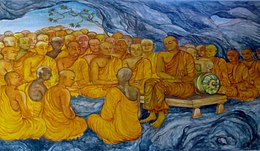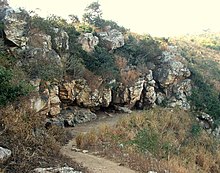| Revision as of 16:51, 7 December 2018 editIdreamofJeanie (talk | contribs)Extended confirmed users, Pending changes reviewers33,797 editsNo edit summary← Previous edit | Revision as of 06:54, 1 January 2019 edit undoBallWarapol (talk | contribs)18 edits →DescriptionNext edit → | ||
| Line 9: | Line 9: | ||
| A council of 500 ] was held at ] (Sanskrit: Rājagṛha) three months following the Buddha's death to agree on the contents of the Dhamma and Vinaya.{{sfn |Harvey |2013 |p=88}}<ref>{{Cite web|url=https://www.buddhanet.net/e-learning/buddhism/lifebuddha/2_32lbud.htm|title=Life of Buddha: The 1st Buddhist Council (Part 2)|website=www.buddhanet.net|access-date=2017-12-30}}</ref> It is said that following the Buddha's death, 499 of the Buddha's top arahats were chosen to attend the council, with one seat reserved for ], then a ]. As the meeting approached, Ananda trained himself until the dawn of day of the council. When the dawn arrived, he decided to lie down and before his head hit the pillow he became an arahant.<ref>{{Cite web|url=https://www.buddhanet.net/e-learning/buddhism/lifebuddha/2_32lbud.htm|title=Life of Buddha: The 1st Buddhist Council (Part 2)|website=www.buddhanet.net|access-date=2017-12-30}}</ref> | A council of 500 ] was held at ] (Sanskrit: Rājagṛha) three months following the Buddha's death to agree on the contents of the Dhamma and Vinaya.{{sfn |Harvey |2013 |p=88}}<ref>{{Cite web|url=https://www.buddhanet.net/e-learning/buddhism/lifebuddha/2_32lbud.htm|title=Life of Buddha: The 1st Buddhist Council (Part 2)|website=www.buddhanet.net|access-date=2017-12-30}}</ref> It is said that following the Buddha's death, 499 of the Buddha's top arahats were chosen to attend the council, with one seat reserved for ], then a ]. As the meeting approached, Ananda trained himself until the dawn of day of the council. When the dawn arrived, he decided to lie down and before his head hit the pillow he became an arahant.<ref>{{Cite web|url=https://www.buddhanet.net/e-learning/buddhism/lifebuddha/2_32lbud.htm|title=Life of Buddha: The 1st Buddhist Council (Part 2)|website=www.buddhanet.net|access-date=2017-12-30}}</ref> | ||
| The meeting was led by ] under the patronage of the king ]. Its objective was to preserve the Buddha's sayings (]) and the monastic discipline or rules (]). Even though the Buddha allowed the Sangha to abolish the minor rules, the ] made the unanimous decision to keep all the rules of the Vinaya. ] recited the Suttas, such that each begins: ‘]’ (Pali: ''Evaṃ me sutaṃ'').{{sfn |Harvey |2013 |p=88}} The monk ] (Sanskrit उपालि upāli) recited the Vinaya.{{sfn |Harvey |2013 |p=88}} |
The meeting was led by ] under the patronage of the king ]. Its objective was to preserve the Buddha's sayings (]) and the monastic discipline or rules (]). Even though the Buddha allowed the Sangha to abolish the minor rules, the ] made the unanimous decision to keep all the rules of the Vinaya. ] recited the Suttas, such that each begins: ‘]’ (Pali: ''Evaṃ me sutaṃ'').{{sfn |Harvey |2013 |p=88}} The monk ] (Sanskrit उपालि upāli) recited the Vinaya.{{sfn |Harvey |2013 |p=88}} The westerner professors, in 17th century CE, think ] likely composed starting about and after 300 BCE because it's literature style is different from Sutta.{{sfn|Gombrich|2006|p=4}}<ref name="Keown2004p2">{{cite book|author=Damien Keown |title=A Dictionary of Buddhism |url=https://books.google.com/books?id=985a1M7L1NcC |year=2004|publisher=Oxford University Press |isbn=978-0-19-157917-2 |pages=2 }}</ref> However, the Atthakathā-teachers, who were the memorizers of the Tipiṭaka between Buddha living time to 0 CE before the pāli canons written on the paper in Siṅhala, told the six canons of Abhidhamma Pitaka, one of its Matika, and the ancient Atthakathā '''were also included at the first Buddhist council''' in Sutta category, but its literature is different from Sutta because Abhidhamma Pitaka was authored by ]<ref>Dī.A. (sumaṅgala.1) Sumaṅgalavilāsinī dīghanikāyaṭṭhakathā </ref><ref>Saṅgaṇi.A. (aṭṭhasālinī) Dhammasaṅgiṇī </ref>. Also, the ] made the unanimous decision to keep all the rules of the Vinaya, even the lesser and the minor rules.<ref>(1) (Recitation with) Five Hundred (Pañcasata), (2) Dī.A. (sumaṅgala.1 syāmaraṭṭha) Page 12 , (3) Dī.A. (sumaṅgala.2 syāmaraṭṭha) Page 200 </ref> | ||
| == Historicity == | == Historicity == | ||
Revision as of 06:54, 1 January 2019
Part of early Buddhist history

| Part of a series on |
| Early Buddhism |
|---|
 |
| Buddhism |
Scriptures
|
| Early sangha |
| Pre-sectarian Buddhism |
Early Buddhist schools
|
| Terms |
The First Buddhist council was a gathering of senior monks of the Buddhist order convened just after Gautama Buddha's death in ca. 400 BCE. The story of the gathering is recorded in the Vinaya Pitaka of the Theravadins and Sanskrit Buddhist schools. It is regarded as canonical by all schools of Buddhism, but in the absence of evidence from outside the Buddhist sutras some scholars have expressed doubts as to the event's historicity.
Description
A council of 500 Arahants was held at Rajgir (Sanskrit: Rājagṛha) three months following the Buddha's death to agree on the contents of the Dhamma and Vinaya. It is said that following the Buddha's death, 499 of the Buddha's top arahats were chosen to attend the council, with one seat reserved for Ananda, then a sotapanna. As the meeting approached, Ananda trained himself until the dawn of day of the council. When the dawn arrived, he decided to lie down and before his head hit the pillow he became an arahant.
The meeting was led by Mahakasyapa under the patronage of the king Ajatashatru. Its objective was to preserve the Buddha's sayings (suttas) and the monastic discipline or rules (Vinaya). Even though the Buddha allowed the Sangha to abolish the minor rules, the Sangha made the unanimous decision to keep all the rules of the Vinaya. Ananda recited the Suttas, such that each begins: ‘Thus have I heard’ (Pali: Evaṃ me sutaṃ). The monk Upali (Sanskrit उपालि upāli) recited the Vinaya. The westerner professors, in 17th century CE, think Abhidhamma Pitaka likely composed starting about and after 300 BCE because it's literature style is different from Sutta. However, the Atthakathā-teachers, who were the memorizers of the Tipiṭaka between Buddha living time to 0 CE before the pāli canons written on the paper in Siṅhala, told the six canons of Abhidhamma Pitaka, one of its Matika, and the ancient Atthakathā were also included at the first Buddhist council in Sutta category, but its literature is different from Sutta because Abhidhamma Pitaka was authored by Sāriputta. Also, the Sangha made the unanimous decision to keep all the rules of the Vinaya, even the lesser and the minor rules.
Historicity
Tradition states that the First Council lasts for seven months. Scholars doubt, however, whether the entire canon was really recited during the First Council, because the early texts contain different accounts on important subjects such as meditation. It may be, though, that early versions were recited of what is now known as the Vinaya-piṭaka and Sutta-piṭaka. Nevertheless, many scholars, from the late 19th century onward, have considered the historicity of the First Council improbable. Some scholars, such as orientalists Louis de La Vallée-Poussin and D.P. Minayeff, thought there must have been assemblies after the Buddha's death, but considered only the main characters and some events before or after the First Council historical. Other scholars, such as Buddhologist André Bareau and Indologist Hermann Oldenberg, considered it likely that the account of the First Council was written after the Second Council, and based on that of the second, since there were not any major problems to solve after the Buddha's death, or any other need to organize the First Council. On the other hand, archaeologist Louis Finot, Indologist E. E. Obermiller and to some extent Indologist Nalinaksha Dutt thought the account of the First Council was authentic, because of the correspondences between the Pāli texts and the Sanskrit traditions.
See also
- Buddhist councils
- Third Buddhist council
- Fourth Buddhist council
- Fifth Buddhist council
- Sixth Buddhist council
References
- ^ Harvey 2013, p. 88.
- Bechert, Heinz; Akademie der Wissenschaften in Göttingen, eds. (1995). When did the Buddha live?: the controversy on the dating of the historical Buddha. Delhi, India: Sri Satguru Publications. ISBN 8170304695.
- "Life of Buddha: The 1st Buddhist Council (Part 2)". www.buddhanet.net. Retrieved 2017-12-30.
- "Life of Buddha: The 1st Buddhist Council (Part 2)". www.buddhanet.net. Retrieved 2017-12-30.
- Gombrich 2006, p. 4.
- Damien Keown (2004). A Dictionary of Buddhism. Oxford University Press. p. 2. ISBN 978-0-19-157917-2.
- Dī.A. (sumaṅgala.1) Sumaṅgalavilāsinī dīghanikāyaṭṭhakathā sīlakkhandhavaggavaṇṇanā nidānakathā
- Saṅgaṇi.A. (aṭṭhasālinī) Dhammasaṅgiṇī Abhidhamma-Atthakathā Nidānakathā
- (1) VN Cullavagga (Recitation with) Five Hundred (Pañcasata), (2) Dī.A. (sumaṅgala.1 syāmaraṭṭha) Page 12 introduction, (3) Dī.A. (sumaṅgala.2 syāmaraṭṭha) Page 200 Mahāparinibbānasuttavaṇṇanā
- Buswell & Lopez 2013, Council, 1st.
- Gombrich, Richard (2006). How Buddhism Began: The Conditioned Genesis of the Early Teachings (2nd ed.). Routledge. pp. 96–7. ISBN 978-0-415-37123-0.
- Hirakawa 1993, p. 69.
- Prebish 2005, p. 226.
- Mukherjee 1994, pp. 453.
- Prebish 2005, p. 231.
- Mukherjee 1994, pp. 454–6.
- Mukherjee 1994, p. 457.
Bibliography
- Buswell, Robert E. Jr.; Lopez, Donald S. Jr. (2013), Princeton Dictionary of Buddhism. (PDF), Princeton University Press, ISBN 978-0-691-15786-3
- Harvey, Peter (2013), An Introduction to Buddhism: Teachings, History and Practices (PDF) (2nd ed.), New York: Cambridge University Press, ISBN 978-0-521-85942-4
- Hirakawa, Akira (1993), A History of Indian Buddhism: From Śākyamuni to Early Mahāyāna (PDF), Motilal Banarsidass Publishers, ISBN 9788120809550
- Mukherjee, B. (1994), "The Riddle of the First Buddhist Council – A Retrospection", Chung-Hwa Buddhist Journal, 7: 452–73
- Prebish, Charles S. (2005) , "Review of Scholarship on Buddhist Councils" (PDF), in Williams, Paul (ed.), Buddhism: Critical Concepts in Religious Studies, 1: Early History in South and Southeast Asia, Routledge, pp. 224–43, ISBN 0-415-33227-3
External Links
- Recitation of the Five Hundred (English translation) - The traditional story of the First Council, as recorded in the Pali Canon.
| Buddhist councils | |
|---|---|